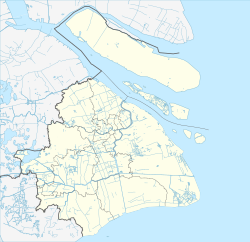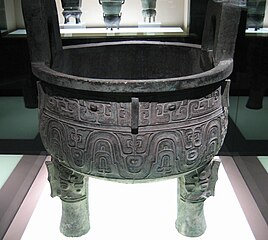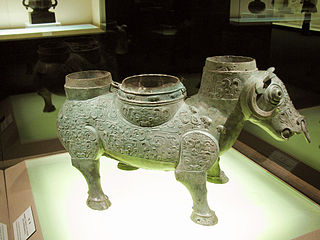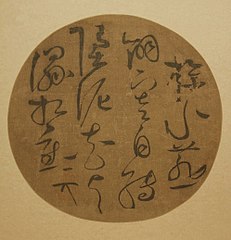| Revision as of 03:14, 30 January 2018 editZanhe (talk | contribs)Autopatrolled, Extended confirmed users, Pending changes reviewers132,020 editsm ce← Previous edit | Latest revision as of 07:43, 25 October 2024 edit undoAlexey Yakovlev (talk | contribs)Extended confirmed users992 editsNo edit summary | ||
| (43 intermediate revisions by 34 users not shown) | |||
| Line 1: | Line 1: | ||
| {{Short description|Museum in the Huangpu District of Shanghai, China}} | |||
| {{Infobox |
{{Infobox museum | ||
| |name = Shanghai Museum | | name = Shanghai Museum | ||
| |native_name = 上海博物馆 | | native_name = 上海博物馆 | ||
| |native_name_lang= | | native_name_lang = zh | ||
| |image = Shanghai Museum exterior 1.jpg | | image = Shanghai Museum exterior 1.jpg | ||
| |imagesize = 300px | |||
| | |
| imagesize = 300px | ||
| | |
| map_type = Shanghai | ||
| |map_caption = Location within ] | | map_size = 250 | ||
| | map_caption = Location within ] | |||
| |coordinates = {{coord|31.230278|121.470556|display=inline}} | | coordinates = {{coord|31.230278|121.470556|display=inline}} | ||
| |established = 1952<ref name="history"></ref><ref name="museum"></ref> | | established = 1952<ref name="history"></ref><ref name="museum"></ref> | ||
| |location = 201 Renmin Avenue, ], ], 200003<ref></ref> | | location = 201 Renmin Avenue, ], ], 200003<ref></ref> | ||
| | visitors = 2,109,200 (2017)<ref>{{cite news |last1=Xu Yicheng |last2=Sun Jiayin |url=http://newsxmwb.xinmin.cn/wentihui/wtsh/2018/01/18/31352609.html |title=2017上海博物馆大数据出炉:红色纪念馆参观人数喷涌式增长 |language=zh |publisher=] |date=18 January 2018 |access-date=22 March 2018}}</ref> | |||
| |visitors = 1.9 million (2013)<ref name="worldranking">, '']'', 2014. Retrieved on 13 July 2014.</ref><br />] (2013)<ref name="worldranking"/> | |||
| |director = ] ( |
| director = ] (1985–1999) | ||
| |publictransit = ] on Lines ], ], and ] (]) | | publictransit = ] on Lines ], ], and ] (]) | ||
| |website = {{URL|www.shanghaimuseum.net}} | | website = {{URL|https://www.shanghaimuseum.net|shanghaimuseum.net}} | ||
| }} | }} | ||
| {{infobox Chinese | |||
| {{Chinese|t=上海博物館|s=上海博物馆|p=Shànghǎi Bówùguǎn|lmz=Zånhae Bomahgue|order=st}} | |||
| | t = 上海博物館 | |||
| | s = 上海博物馆 | |||
| | order = st | |||
| | p = Shànghǎi Bówùguǎn | |||
| | lmz = Zånhae Bomahgue | |||
| | y = Seuhnghói Bokmahtgún | |||
| }} | |||
| The '''Shanghai Museum''' is a municipal public ] of ancient ], situated on the ] in the ] of ], China. It is funded by the Shanghai Municipal Culture and Tourism Bureau. | |||
| Rebuilt at its current location in 1996, it is famous for its large collection of rare cultural pieces. | |||
| The '''Shanghai Museum''' is a ] of ancient ], situated on the ] in the ] of ], China. Rebuilt at its current location in 1996, it is considered one of China's first world-class modern museums.<ref name="becker">{{cite news |url=http://gotheborg.com/qa/mrma.shtml |title=Ma Chengyuan and the creation of Shanghai Museum |author=Jasper Becker |newspaper=South China Morning Post |date=3 January 2001 |accessdate=12 September 2013}}</ref> | |||
| ==History== | ==History== | ||
| ] | ] | ||
| The museum was founded in 1952 and was first open to the public in the former Shanghai Racecourse club house, now at 325 West ].<ref>http://www.shanghaimuseum.net/en/history/history.jsp</ref> The founding collections came principally from three sources: a batch of |
The museum was founded in 1952 and was first open to the public in the former Shanghai Racecourse club house, now at 325 West ].<ref>{{Cite web|url=http://www.shanghaimuseum.net/en/history/history.jsp|title = 上海博物馆}}</ref> The founding collections came principally from three sources: a batch of artifacts gathered by the Communist 3rd Field Army during the civil war from accidental finds and confiscations of private property and brought to Shanghai upon the Communists' conquest of the city; artifacts confiscated by the customs service; items sold by private collectors due to political pressure during political purges and purchased by the government. The former Shanghai Municipal Museum was also merged into the new Shanghai Museum. | ||
| In the next few years, the museum's collections were further enriched from other private and institutional collections in Shanghai, including the collection of the former Shanghai Museum of the ], which were moved to the museum as "foreign" institutions gradually left the city in the 1950s. In 1959 the museum moved into the Zhonghui Building at 16 South Henan Road, which housed insurance companies and bank offices.<ref name="history"/><ref name="museum"/> During the metal-gathering campaign of the ], the Shanghai Museum participated in rescuing bronzeware from metal that had been confiscated or donated and were sent to be melted down. Before the ], a tradition formed whereby Shanghai's wealthy collectors would make annual donations to the museum. |
In the next few years, the museum's collections were further enriched from other private and institutional collections in Shanghai, including the collection of the former Shanghai Museum of the ], which were moved to the museum as "foreign" institutions gradually left the city in the 1950s. In 1959 the museum moved into the Zhonghui Building at 16 South Henan Road, which housed insurance companies and bank offices.<ref name="history"/><ref name="museum"/> During the metal-gathering campaign of the ], the Shanghai Museum participated in rescuing bronzeware from metal that had been confiscated or donated and were sent to be melted down. Before the ], a tradition formed whereby Shanghai's wealthy collectors would make annual donations to the museum. | ||
| The museum's work largely halted as a result of the Cultural Revolution. After the end of the revolution, as one of China's most important museums, the collections have continued to be enriched with the fruit of donations, government purchases, and important finds from archaeological excavations. | The museum's work largely halted as a result of the Cultural Revolution. After the end of the revolution, as one of China's most important museums, the collections have continued to be enriched with the fruit of donations, government purchases, and important finds from archaeological excavations. | ||
| The growth of its collections put enormous pressure on the cramped premises. For his role in ensuring a large, purpose-built home, it is said that Shanghai Museum owes much of its current existence to ], its director from 1985 until his retirement in 1999. When a new museum was omitted from Shanghai's five-year reconstruction plan in 1992, Ma lobbied Mayor ] for its rebuilding. After seeing the dilapidated rooms of the Zhonghui Building, Huang agreed to allocate a prime site on the ], but the museum had to raise its own building funds.<ref name="becker"/><ref name="nyt">{{cite news |url=https://www.nytimes.com/2004/10/15/arts/15ma.html |title=Ma Chengyuan, 77, President of Shanghai Museum, Dies |newspaper=New York Times |date=15 October 2004 | |
The growth of its collections put enormous pressure on the cramped premises. For his role in ensuring a large, purpose-built home, it is said that Shanghai Museum owes much of its current existence to ], its director from 1985 until his retirement in 1999. When a new museum was omitted from Shanghai's five-year reconstruction plan in 1992, Ma lobbied Mayor ] for its rebuilding. After seeing the dilapidated rooms of the Zhonghui Building, Huang agreed to allocate a prime site on the ], but the museum had to raise its own building funds.<ref name="becker">{{cite news |author=Jasper Becker |date=3 January 2001 |title=Ma Chengyuan and the creation of Shanghai Museum |newspaper=South China Morning Post |url=http://gotheborg.com/qa/mrma.shtml |access-date=12 September 2013}}</ref><ref name="nyt">{{cite news |url=https://www.nytimes.com/2004/10/15/arts/15ma.html |title=Ma Chengyuan, 77, President of Shanghai Museum, Dies |newspaper=New York Times |date=15 October 2004 |access-date=9 September 2013}}</ref> Ma raised US$25 million by leasing the old building to a Hong Kong developer. He also made many trips abroad to solicit donations, mainly from the Shanghai diaspora who had fled to Hong Kong after the Communist revolution, raising another $10 million. The money still ran short, but he eventually won another 140 million yuan from the city government to complete the building.<ref name="becker"/> | ||
| Construction of the current building started in August 1993. It was inaugurated on October 12, 1996<ref name="history"/> to wide acclaim.<ref name="nyt"/> It is 29.5 meters high with five floors, covering a total area of 39,200 m |
Construction of the current building started in August 1993. It was inaugurated on October 12, 1996<ref name="history"/> to wide acclaim.<ref name="nyt"/> It is 29.5 meters high with five floors, covering a total area of 39,200 m<sup>2</sup>.<ref name="history"/> | ||
| Designed by local architect Xing Tonghe,<ref name="museum"/> the building is designed in the shape of an ancient bronze cooking vessel called a '']''. It is said that the inspiration for the design was specifically provided by the Da Ke |
Designed by local architect Xing Tonghe,<ref name="museum"/> the building is designed in the shape of an ancient bronze cooking vessel called a '']''. It is said that the inspiration for the design was specifically provided by the ], now on exhibit in the museum. The building has a round top and a square base, symbolizing the ancient Chinese perception of the world as "round sky, square earth" ({{zh|c=天圆地方|links=no}}<ref>{{Cite journal|last=Zhongshu|first=Zhao|date=1992-01-01|title=Round Sky and Square Earth (Tian Yuan Di Fang): Ancient Chinese Geographical Thought and its Influence|jstor=41145346|journal=GeoJournal|volume=26|issue=2|pages=149–152}}</ref>). | ||
| ==Collections== | ==Collections== | ||
| ] | ] | ||
| The museum has a collection of over 120,000 pieces, including ], ]s, ], ], ]s, ancient ]s, ]s, ], ]s, minority art and foreign art. | The museum has a collection of over 120,000 pieces, including ], ]s, ], ], ]s, ancient ]s, ]s, ], ]s, minority art and foreign art. | ||
| The Shanghai Museum houses several items of national importance, including one of three extant specimens of a "transparent" bronze mirror from the ]. | The Shanghai Museum houses several items of national importance, including one of three extant specimens of a "transparent" bronze mirror from the ]. | ||
| ===Galleries=== | ===Galleries=== | ||
| Line 49: | Line 59: | ||
| * Gallery of Ancient ] | * Gallery of Ancient ] | ||
| * Gallery of Ancient Chinese ] | * Gallery of Ancient Chinese ] | ||
| * Gallery of ] in ] and ] dynasties | * Gallery of ] in ] and ] dynasties | ||
| * Gallery of Arts and Crafts by ] | * Gallery of Arts and Crafts by ] | ||
| ⚫ | <gallery mode="packed" heights="160px"> | ||
| ⚫ | File:You with zigzag thunder pattern.jpg|] with zigzag thunder pattern, early ] | ||
| ⚫ | <gallery mode=packed heights=160px> | ||
| File:上海博物馆藏汝窑青瓷.JPG|] porcelain wares from the ] | |||
| ⚫ | File:You with zigzag thunder pattern.jpg|] with zigzag thunder pattern, early ] | ||
| File:上海博物馆藏 |
File:上海博物馆藏明式家具.JPG|Ming dynasty style furniture and room arrangement | ||
| ⚫ | File:Tibetalian's mask.JPG|Colour lacquered ''Tiaoshen'' ({{lang|zh|跳神}}) Mask of Tibetan ethnicity | ||
| File:上海博物馆藏明式家具.JPG|Ming Dynasty style furniture and room arrangement | |||
| File:Westerner on a camel.jpg|]n on a camel, in '']'' style, ] | |||
| ⚫ | File:Tibetalian's mask.JPG|Colour lacquered ''Tiaoshen'' (跳神) Mask of Tibetan ethnicity | ||
| File: |
File:Da Ke ding.jpg|], from late ] | ||
| File: |
File:Hunyuan Xizun.jpg|Xi ] ({{lang|zh|牺尊}}), from the late ] | ||
| File:Hunyuan Xizun.jpg|Xi ] (牺尊), from the late ] | |||
| File:Jinhousu Bianzhong.JPG|] of Marquis Su of Jin, from Western Zhou | File:Jinhousu Bianzhong.JPG|] of Marquis Su of Jin, from Western Zhou | ||
| File:Round fan with grass style writting by Zhao Ji.jpg|Calligraphy on a round fan by ] | File:Round fan with grass style writting by Zhao Ji.jpg|Calligraphy on a round fan by ] | ||
| </gallery> | </gallery> | ||
| ===Numismatic Collections=== | ===Numismatic Collections=== | ||
| The |
The museum has an important collection of ancient coins from the Silk Road, donated since 1991 by Linda and Roger Doo. The collection contains 1783 pieces from the Greeks to the Mongol Empire.<ref>Chen, Doo, and Wang, 2006</ref> | ||
| ==Selected publications== | ==Selected publications== | ||
| ] | |||
| *''Ancient Chinese Ceramic Gallery The Shanghai Museum''. Shanghai: Shanghai Classics Publishing House, 1996. (English & Mandarin Chinese edition.) {{ISBN|7-5325-1721-7}} | *''Ancient Chinese Ceramic Gallery The Shanghai Museum''. Shanghai: Shanghai Classics Publishing House, 1996. (English & Mandarin Chinese edition.) {{ISBN|7-5325-1721-7}} | ||
| ==See also== | ==See also== | ||
| * ] | * ] | ||
| * ] | * ] | ||
| Line 82: | Line 93: | ||
| ==External links== | ==External links== | ||
| {{ |
{{Commons category}} | ||
| {{Portal|Shanghai}} | |||
| * | * | ||
| * | * | ||
| * | * | ||
| {{Huangpu District, Shanghai}} | |||
| {{Museums in Shanghai}} | {{Museums in Shanghai}} | ||
| {{Authority control}} | |||
| ] | ] | ||
| ] | ] | ||
| ] | ] | ||
| ⚫ | ] | ||
| ⚫ | ] | ||
| ] | ] | ||
| ] | ] | ||
| ⚫ | ] | ||
| ⚫ | ] | ||
Latest revision as of 07:43, 25 October 2024
Museum in the Huangpu District of Shanghai, China| 上海博物馆 | |
 | |
 | |
| Established | 1952 |
|---|---|
| Location | 201 Renmin Avenue, People's Square, Shanghai, 200003 |
| Coordinates | 31°13′49″N 121°28′14″E / 31.230278°N 121.470556°E / 31.230278; 121.470556 |
| Visitors | 2,109,200 (2017) |
| Director | Ma Chengyuan (1985–1999) |
| Public transit access | People's Square Station on Lines 1, 2, and 8 (Shanghai Metro) |
| Website | shanghaimuseum.net |
| Shanghai Museum | |||||||||||||||
|---|---|---|---|---|---|---|---|---|---|---|---|---|---|---|---|
| Simplified Chinese | 上海博物馆 | ||||||||||||||
| Traditional Chinese | 上海博物館 | ||||||||||||||
| |||||||||||||||
The Shanghai Museum is a municipal public museum of ancient Chinese art, situated on the People's Square in the Huangpu District of Shanghai, China. It is funded by the Shanghai Municipal Culture and Tourism Bureau.
Rebuilt at its current location in 1996, it is famous for its large collection of rare cultural pieces.
History

The museum was founded in 1952 and was first open to the public in the former Shanghai Racecourse club house, now at 325 West Nanjing Road. The founding collections came principally from three sources: a batch of artifacts gathered by the Communist 3rd Field Army during the civil war from accidental finds and confiscations of private property and brought to Shanghai upon the Communists' conquest of the city; artifacts confiscated by the customs service; items sold by private collectors due to political pressure during political purges and purchased by the government. The former Shanghai Municipal Museum was also merged into the new Shanghai Museum.
In the next few years, the museum's collections were further enriched from other private and institutional collections in Shanghai, including the collection of the former Shanghai Museum of the Royal Asiatic Society, which were moved to the museum as "foreign" institutions gradually left the city in the 1950s. In 1959 the museum moved into the Zhonghui Building at 16 South Henan Road, which housed insurance companies and bank offices. During the metal-gathering campaign of the Great Leap Forward, the Shanghai Museum participated in rescuing bronzeware from metal that had been confiscated or donated and were sent to be melted down. Before the Cultural Revolution, a tradition formed whereby Shanghai's wealthy collectors would make annual donations to the museum.
The museum's work largely halted as a result of the Cultural Revolution. After the end of the revolution, as one of China's most important museums, the collections have continued to be enriched with the fruit of donations, government purchases, and important finds from archaeological excavations.
The growth of its collections put enormous pressure on the cramped premises. For his role in ensuring a large, purpose-built home, it is said that Shanghai Museum owes much of its current existence to Ma Chengyuan, its director from 1985 until his retirement in 1999. When a new museum was omitted from Shanghai's five-year reconstruction plan in 1992, Ma lobbied Mayor Huang Ju for its rebuilding. After seeing the dilapidated rooms of the Zhonghui Building, Huang agreed to allocate a prime site on the People's Square, but the museum had to raise its own building funds. Ma raised US$25 million by leasing the old building to a Hong Kong developer. He also made many trips abroad to solicit donations, mainly from the Shanghai diaspora who had fled to Hong Kong after the Communist revolution, raising another $10 million. The money still ran short, but he eventually won another 140 million yuan from the city government to complete the building.
Construction of the current building started in August 1993. It was inaugurated on October 12, 1996 to wide acclaim. It is 29.5 meters high with five floors, covering a total area of 39,200 m.
Designed by local architect Xing Tonghe, the building is designed in the shape of an ancient bronze cooking vessel called a ding. It is said that the inspiration for the design was specifically provided by the Da Ke ding, now on exhibit in the museum. The building has a round top and a square base, symbolizing the ancient Chinese perception of the world as "round sky, square earth" (Chinese: 天圆地方).
Collections

The museum has a collection of over 120,000 pieces, including bronze, ceramics, calligraphy, furniture, jades, ancient coins, paintings, seals, sculptures, minority art and foreign art. The Shanghai Museum houses several items of national importance, including one of three extant specimens of a "transparent" bronze mirror from the Han dynasty.
Galleries
It has eleven galleries and three special temporary exhibition halls. The permanent galleries are:
- Gallery of Ancient Chinese Bronze
- Gallery of Ancient Chinese Sculpture
- Gallery of Ancient Chinese Ceramics
- Gallery of Ancient Chinese Jades
- Gallery of Ancient Chinese Paintings
- Gallery of Ancient Chinese Calligraphy
- Gallery of Ancient Chinese Seals
- Gallery of Ancient Chinese Numismatics
- Gallery of Chinese furniture in Ming and Qing dynasties
- Gallery of Arts and Crafts by Chinese Minorities
-
 You with zigzag thunder pattern, early Zhou dynasty
You with zigzag thunder pattern, early Zhou dynasty
-
Ru ware porcelain wares from the Northern Song dynasty
-
Ming dynasty style furniture and room arrangement
-
Colour lacquered Tiaoshen (跳神) Mask of Tibetan ethnicity
-
 Sogdian on a camel, in Sancai style, Tang dynasty
Sogdian on a camel, in Sancai style, Tang dynasty
-
 Da Ke ding, from late Western Zhou
Da Ke ding, from late Western Zhou
-
 Xi Zun (牺尊), from the late Spring and Autumn period
Xi Zun (牺尊), from the late Spring and Autumn period
-
Bianzhong of Marquis Su of Jin, from Western Zhou
-
 Calligraphy on a round fan by Emperor Huizong of Song
Calligraphy on a round fan by Emperor Huizong of Song
Numismatic Collections
The museum has an important collection of ancient coins from the Silk Road, donated since 1991 by Linda and Roger Doo. The collection contains 1783 pieces from the Greeks to the Mongol Empire.
Selected publications

- Ancient Chinese Ceramic Gallery The Shanghai Museum. Shanghai: Shanghai Classics Publishing House, 1996. (English & Mandarin Chinese edition.) ISBN 7-5325-1721-7
See also
References
- ^ Shanghai Museum
- ^ American Friends of the Shanghai Museum
- Service Installation – Visitor's Information
- Xu Yicheng; Sun Jiayin (18 January 2018). "2017上海博物馆大数据出炉:红色纪念馆参观人数喷涌式增长" (in Chinese). Xinmin Evening News. Retrieved 22 March 2018.
- "上海博物馆".
- ^ Jasper Becker (3 January 2001). "Ma Chengyuan and the creation of Shanghai Museum". South China Morning Post. Retrieved 12 September 2013.
- ^ "Ma Chengyuan, 77, President of Shanghai Museum, Dies". New York Times. 15 October 2004. Retrieved 9 September 2013.
- Zhongshu, Zhao (1992-01-01). "Round Sky and Square Earth (Tian Yuan Di Fang): Ancient Chinese Geographical Thought and its Influence". GeoJournal. 26 (2): 149–152. JSTOR 41145346.
- Shanghai Museum
- Chen, Doo, and Wang, 2006
Bibliography
Chen Xiejan, Doo R, Wang Yue (2006) Shanghai Museum's Collection of Ancient Coins from the Silk Road
External links
| Huangpu District, Shanghai | |||
|---|---|---|---|
| Landmarks |
| ||
| This list is incomplete. | |||